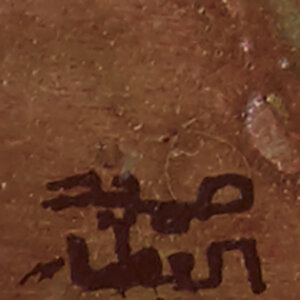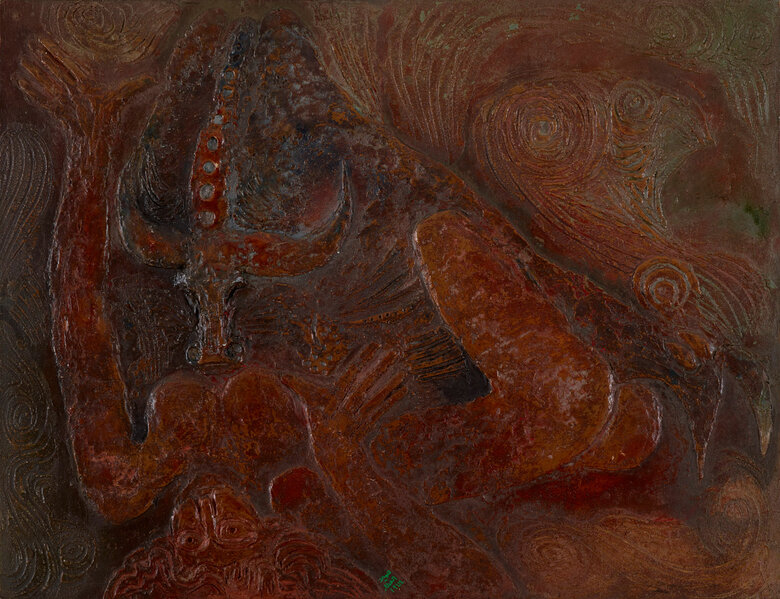Born in Karbala, Iraq, in 1935, Hamid al-Attar actually trained as a lawyer before embarking on a career as an artist. Al-Attar graduated in 1955 from the University of Baghdad with a law degree,...


HAMID AL-ATTAR, Iraq (1933 - 2006)
Bio
Written by MYSA KAFIL-HUSSAIN
Born in Karbala, Iraq, in 1935, Hamid al-Attar actually trained as a lawyer before embarking on a career as an artist. Al-Attar graduated in 1955 from the University of Baghdad with a law degree, and then proceeded to pursue artistic training in Baghdad, Germany and Egypt, where he received a Diploma in Art Criticism from Cairo University.[1] Whilst studying art in Baghdad, he was taught by the renowned artist Atta Sabri, and worked alongside peers such as Kadhim Haydar, Muhammed Muhraddin and Idan al-Sheikhly.[2] In this time, he was also a co-founding member of the Iraqi Plastic Artists Society, which was established in 1956 and exists to this day.
His early works from the 1950s caught the eyes of many, with his paintings full of city scenes, local motifs and folkloric patterns and abound with vibrancy and warmth. Being trained by master artists led al-Attar to embrace his full potential quickly and he soon found his personal style. His paintings of the Baghdad souqs and streets in the 1950s shifted in the 1960s to experimental collages of local fabrics, before moving on to explorations of mythical and historical themes from Iraqi heritage, such as Sumerian and Assyrian heroic and tragic tales – a “desire for immortality and survival…a call from the past” according to fellow artist and writer Nizar Selim.[3] Figures such as Ishtar and Gilgamesh feature heavily in his work, using a mix of painting, collage and bas-relief in a modern retelling of their stories. Historian, artist and critic Jabra Ibrahim Jabra sees in al-Attar’s explorations of Gilgamesh a struggle for “godship that cannot be attained.”[4] This may have been al-Attar’s way of creatively interpreting and visualising the endless political movements and quests for power in Iraq at the time, as well as his own personal struggles, aligning with the tales and moral lessons from ancient history.
Although he had been painting for many years, he was recognised on the national stage for the first time during the Battle Exhibition in May 1968, a politically-charged event which included 28 painters and 5 sculptors including Ismail al-Cheikhli, Nouri al-Rawi, Dia al-Azzawi and many other prominent names.[5] His work took on greater depths, exploring complex expressions of political consciousness, humanitarianism and social concerns. Interestingly, writer Jassim Al-Assi considers this perhaps as an natural trait in al-Attar’s moral and ethical view of the world, connecting with his training and interest in law and social justice.[6] As part of this, he also interrogated class and identity politics, as well as the role of women and their suffering.
“We are living wearing death’s shroud under the wing of alleged freedom. We appear free in a very big prison cell. Fear permeates us day and night and we are always at the mercy of the visitor of death - forgive me - the dawn visitor. And from the set-backs of this kind of life, my work was born. It is important not to deceive people with smoke screens, but to shock them face on in order to stir them into action, to make them revolt against their oppressive reality.” Hamid al-Attar, 1998[7]
Both of al-Attar’s artworks in the Dalloul Collection – Untitled (1974) and Road to Palestine (1982) – are created with mixed media on board, with the range of textures, patterns and colours creating a harmonious but also chaotic vision into his creative mind. Untitled appears as a cinematic and energetic scene involving a woman being mounted by an animal or mythical beast, with her hair, limbs and fingers intertwining with the twirling, moving lines in the wind. Like much of his work, this is thought to be a scene from the epic of Gilgamesh, in which the beast may be Enkidu, the beloved friend of Gilgamesh who sometimes took the form of a bull-man. In the tale, Enkidu mated with Shamhat, a sacred temple prostitute, for many days before she then civilised and tamed him. The painted scene by al-Attar may be his interpretation of this phase of the epic story. Road to Palestine, one of al-Attar’s more political works, is an abstract exploration of the ongoing regional conflict, and possibly painted after the Sabra and Shatila massacre of Palestinians in Lebanon during that same year. Figures standing above ground appear frozen and almost stoic, whilst numerous heads and bodies stand below the ground, possibly representing the dead: imprisoned, lifeless and laced with silent sadness. It is unclear if the two figures above are Palestinians, Israelis, Lebanese or from anywhere in particular, but they stand suspended in time, upright and front-facing, just like many Sumerian statues which al-Attar undoubtedly encountered over years of exploring ancient art and mythology. As suggested by al-Assi, al-Attar’s use of colour represents what he sees in reality, expressed dynamically through the tonal subtleties and intensity of his thoughts and imagination.[8]
Al-Attar continued to exhibit inside and outside of Iraq and produced work throughout the 1980s and 1990s. In 2003, following the invasion of Iraq and the subsequent violence, one of al-Attar’s paintings was stolen from the Saddam Arts Centre along with many other artworks. Years later, it was miraculously found and delivered by artist Saadi al-Kaabi, who then handed it over to officials[9] Following this and other initiatives to locate stolen material, the government emphasized the need for respecting the country’s heritage and restoring looted goods.
After moving to London many years before, al-Attar passed away at his home in December 2016, surrounded by his artwork. He had suffered depression for some time, and had stopped painting for roughly the last ten years of his life, having thrown himself into his work previously.[10]
Throughout his life, al-Attar’s work had a complex relationship with humanity, past and present. Whilst he used his imagination and his paintbrush as weapons to defend and speak up for others on canvas, these paintings also became almost like self-portraits, reflecting the struggles he faced himself.[11]
Notes
[1] Aya Gallery (2003), “Al-Iraq. Hamid al-Attar. March-July 2003”, n.pag
[2] Wissam Qusai (2018), “ الفنون تسترد لوحة للعطار وتفتتح زوايا تشكيلية”, n.pag
[3] Nizar Selim (1977), Iraq Contemporary Art: Volume 1 – Painting, p. 219
[4] Jabra Ibrahim Jabra (1983), The Grass Roots of Iraqi Art, p.62
[5] Selim (1977), p.219
[6] Jassim al-Assi (2020), “التجربة الفكرية والجمالية في لوحات العراقي حميد العطار”, n.pag
[7] Ulrike al-Khamis (1999), “Artist statement: Hamid al-Attar”, n.pag
[8] Ibid
[9] Qusai (2018), n.pag
[10] Kadhim Habib (2016), “مات الفنان التشكيلي حميد العطار”, n.pag
[11] Al-Khamis (1999), n.pag
Sources
Al-Khamis, Ulrike (1999), “Artist statement: Hamid al-Attar”, in INCIA.co.uk. Accessed July 2020. http://www.incia.co.uk/4721.html
Al-Assi, Jassim (2020). “التجربة الفكرية والجمالية في لوحات العراقي حميد العطار”, In Alquds.co.uk. Accessed July 2020. http://www.alquds.co.uk/التجربة-الفكرية-والجمالية-في-لوحات-ال/
Habib, Kadhim (2016). “مات الفنان التشكيلي حميد العطار”, In Ahewar.org. Accessed July 2020. http://www.ahewar.org/debat/show.art.asp?aid=542286&r=0
Jabra, Jabra Ibrahim (1983). The Grass Roots of Iraqi Art. Wasit Graphic and Publishing Limited: Baghdad, Iraq
Qusai, Wissam (2018). “ الفنون تسترد لوحة للعطار وتفتتح زوايا تشكيلية”, In NewSabah.com. Accessed July 2020. http://newsabah.com/newspaper/143751
Selim, Nizar (1977). Iraq Contemporary Art: Volume 1 – Painting. Sartec: Lausanne, Switzerland
Aya Gallery (n.d.). “Al-Iraq. Hamid al-Attar. March-July 2003”, In Exhibitions – Aya Gallery, AyaGallery.co.uk. Accessed July 2020. http://www.ayagallery.co.uk/4666.html
CV
Solo Exhibitions
2003
Aya Gallery, London, United Kingdom
1968
Baghdad, Iraq
1967
Baghdad, Iraq
Group Exhibitions
2003
Iraqi Art Now: Looking Out, Looking In, DePaul Art Museum, Illinois, United States of America
2002
Strokes of Genius: Contemporary Iraqi Art, Faulconer Gallery, Grinnel College, Iowa, United States of America
2001
Strokes of Genius: Contemporary Iraqi Art, Exeter; Bath, United Kingdom
2000
Strokes of Genius: Contemporary Iraqi Art, Brunei Gallery, SOAS University, London, United Kingdom
1983
Peoples’ Hall, Union of Fine Arts, Damascus, Syria
1974
First Arab Biennale, Baghdad, Iraq
1972
Al-Wasiti Festival, Baghdad, Iraq
First Arab Festival of National Plastic Art, Damascus, Syria
1968
Battle Exhibition, Baghdad, Iraq
1965
L’Exposition Itinerante de Peinture, Sursock Museum, Beirut, Lebanon
Affiliations & Memberships
1956
Founding Member, Society of Iraqi Plastic Art
Date Unknown
Iraqi Artists Society
Collections
Azzawi Collection, London, United Kingdom
Ramzi & Saeda Dalloul Foundation, Beirut, Lebanon
Press
الثراء في اللون والملمس في أعمال حميد العطار – الفنان التشكيلي حميد العطار.pdf
التجربة الفكرية والجمالية في لوحات العراقي حميد العطار – الفنان التشكيلي حميد العطار.pdf
كاظم حبيب - مات الفنان التشكيلي حميد العطار!.pdf
فنانون عراقيون يعرضون في بيروت . خط بياني بين التراث واسئلة الحداثة .pdf
حميد العطار .. غواية الأسطورة .. وروح الرسم – الفنان التشكيلي حميد العطار.pdf
التشكيل بين الفكر والجمال في لوّحات الفنان حميد العطـــار – الفنان التشكيلي حميد العطار.pdf
حميد العطار..الرسم نفاذ الى عمق المأساة – الفنان التشكيلي حميد العطار.pdf
رموز حميد العطار في التراث القديم لايلزمه بأنماطه – الفنان التشكيلي حميد العطار.pdf
حميد العطار_اسئلة الفن المستدامة – الفنان التشكيلي حميد العطار.pdf
فن حميد العطار.. الاثنانية والتوحيد في آن واحد – الفنان التشكيلي حميد العطار.pdf
اعمال حميد العطار ليست تصويرا تقليديا – الفنان التشكيلي حميد العطار.pdf
الفنون تسترد لوحة للعطار وتفتتح زوايا تشكيلية – جريدة الصباح الجديد.pdf
مات الفنان التشكيلي حميد العطار في الغربة أيضاً! - مركز النور.pdf
التجربة الفكرية والجمالية في لوحات العراقي حميد العطار _ القدس العربي.pdf
HAMID AL-ATTAR Artwork
Become a Member
Join us in our endless discovery of modern and contemporary Arab art
Become a Member
Get updates from DAF
Follow Artists
Save your favourite Artworks
Share your perspectives on Artworks
Be part of our community
It's Free!
We value your privacy
TermsCookiesPrivacy Policies
Become a Member
Get updates from DAF
Follow Artists
Save your favourite Artworks
Share your perspectives on Artworks
Be part of our community
It's Free!
We value your privacy
TermsCookiesPrivacy Policies
Become a Member
Get updates from DAF
Follow Artists
Save your favourite Artworks
Share your perspectives on Artworks
Be part of our community
It's Free!
We value your privacy
TermsCookiesPrivacy Policies
Welcome to the Dalloul Art Foundation
Thank you for joining our community
If you have entered your email to become a member of the Dalloul Art Foundation, please click the button below to confirm your email and agree to our Terms, Cookie & Privacy policies.
We value your privacy, see how
Become a Member
Get updates from DAF
Follow Artists
Save your favourite Artworks
Share your perspectives on Artworks
Be part of our community
It's Free!
We value your privacy
TermsCookiesPrivacy Policies






